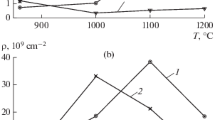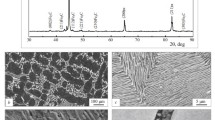Conclusions
-
1.
The best combination of mechanical properties in low-alloy steel with a high carbon content can be obtained by HTTMT+IH.
-
2.
In HTTMT+IH of such steels the holding time after hot deformation should be short (10–15 sec) for completion of polygonization processes and the initial stage of recrystallization. This brief period greatly simplifies HTTMT and HTTMT+IH. It does not reduce the structural strength, but in some cases even raises it. The holding time must be determined experimentally on the basis of the composition of the steel, the deformation conditions, and the application.
Similar content being viewed by others
Literature cited
M. M. Noskov and Ya. Ya. Rauzin, "Means of increasing the contact fatigue strength of rail steel," in: Transactions of the All-Union Scientific-Research Institute of Railroad Transportation; Means of Increasing the Service Life of Rails and Frogs [in Russian], No. 434, Transport, Moscow (1971), p. 70.
Ya. R. Rauzin, M. M. Noskov, and E. A. Shur, "Structural strength of steels operating under cyclic loads," Metal. i Term. Obrabotka Metal., No. 9, 20 (1969).
V. I. Malovitskaya and Ya. R. Rauzin, Zh. Tekh. Fiz.,21, No. 4, 351 (1951).
K. I. Tushinskaya et al., in: Hardening of Carbon Steel by Microalloying and Thermomechanical Treatment [in Russian], Novosibirsk (1968), p. 47.
L. V. Smirnov, E. N. Sokolkov, and V. D. Sadovskii, Dokl. Akad. Nauk SSSR,103, No. 4, 609 (1955).
L. V. Smirnov and V. D. Sadovskii, in: Problems of Metal Science and Heat Treatment [in Russian], Mashgiz, Moscow (1956), p. 223.
E. N. Sokolkov and V. D. Sadovskii, Fiz. Metal. i Metalloved.,19, No. 2, 226 (1965).
M. L. Bernshtein, Heat Treatment of Metals and Alloys [in Russian], Metallurgiya, Moscow (1968), p. 695.
Ya. R. Rauzin, Heat Treatment of Chromium Steel [in Russian], Mashgiz, Moscow (1955), p. 300.
Ya. R. Rauzin, "Quenching steel from forging heat," Vestnik Mashinostroeniya, No. 4, 45–49 (1952).
M. E. Blanter et al., "Effect of thermomechanical treatment with extrusion on mechanical properties of steel," Metal. i Term. Obrabotka Metal., No. 8, 16–21 (1964).
D. I. Bron, I. I. Levites, and M. N. Shashina, "Recrystallization of steel 55KhGR during high-temperature thermomechanical treatment," Metal. i Term. Obrabotka Metal., No. 2, 44 (1965).
V. I. Kumanin, "Failure of Cr−Ni steel subjected to thermomechanical treatment," Metal. i Term. Obrabotka Metal., No. 12, 37–40 (1967).
E. N. Sokolkov and S. N. Petrova, Fiz. Metal. i Metalloved.,7, No. 2, 306 (1959).
M. L. Bernshtein, Stal', No. 2, 157–164 (1972).
Additional information
TsNII MPS. Trasslated from Metallovedenie i Termicheskaya Obrabotka Metallov, No. 9, pp. 5–7, September, 1973.
Rights and permissions
About this article
Cite this article
Rauzin, Y.R., Shur, E.A. & Zonov, P.N. Heat and thermomechanical treatments of high-carbon structural steel. Met Sci Heat Treat 15, 729–731 (1973). https://doi.org/10.1007/BF00656279
Issue Date:
DOI: https://doi.org/10.1007/BF00656279




